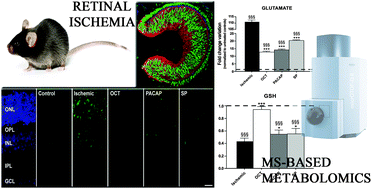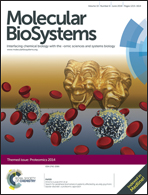Protective effects of the neuropeptides PACAP, substance P and the somatostatin analogue octreotide in retinal ischemia: a metabolomic analysis†
Abstract
Ischemia is a primary cause of neuronal death in retinal diseases and the somatostatin subtype receptor 2 agonist octreotide (OCT) is known to decrease ischemia-induced retinal cell death. Using a recently optimized ex vivo mouse model of retinal ischemia, we tested the anti-ischemic potential of two additional neuropeptides, pituitary adenylate cyclase activating peptide (PACAP) and substance P (SP), and monitored the major changes occurring at the metabolic level. Metabolomics analyses were performed via fast HPLC online using a microTOF-Q MS instrument, a workflow that is increasingly becoming the gold standard in the field of metabolomics. The metabolomic approach allowed detection of the most significant alterations induced in the retina by ischemia and of the significance of the protective effects exerted by OCT, PACAP or SP. All treatments were shown to reduce ischemia-induced cell death, vascular endothelial growth factor over-expression and glutamate release. The metabolomic analysis showed that OCT and, to a lesser extent, also PACAP or SP, were able to counteract the ischemia-induced oxidative stress and to promote, with various efficacies, (i) decreased accumulation of glutamate and normalization of glutathione homeostasis; (ii) reduced build-up of α-ketoglutarate, which might serve as a substrate for the enhanced biosynthesis of glutamate in response to ischemia; (iii) reduced accumulation of peroxidized lipids and inflammatory mediators; (iv) the normalization of glycolytic fluxes and thus preventing the over-accumulation of lactate or either promoting the down-regulation of the glyoxalate anti-oxidant system; (v) a reduced metabolic shift from glycolysis towards the PPP or either a blockade at the non-oxidative phase of the PPP; and (vi) tuning down of purine metabolism. In addition, OCT seemed to stimulate nitric oxide production. None of the treatments was able to restore ATP production, although ATP reservoirs were partly replenished by OCT, PACAP or SP. These data indicate that, in addition to that of somatostatin, peptidergic systems such as those of PACAP and SP deserve attention in view of peptide-based therapies to treat ischemic retinal disorders.

- This article is part of the themed collection: Italian Proteomics Association, 2014

 Please wait while we load your content...
Please wait while we load your content...